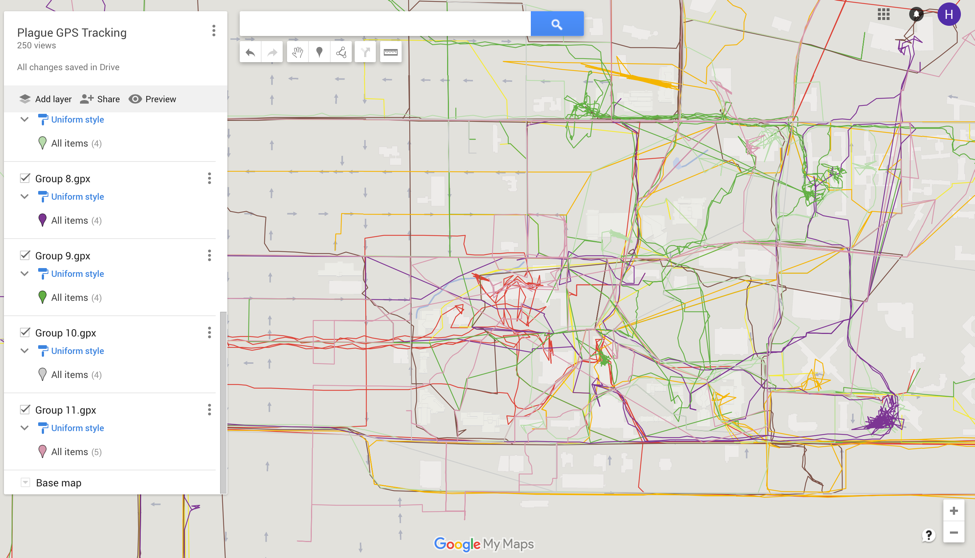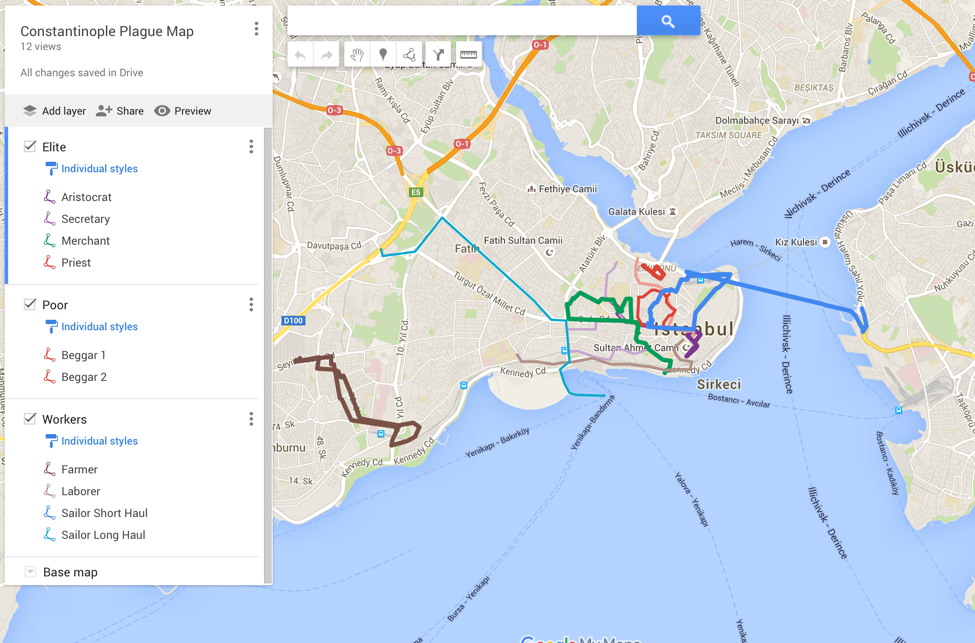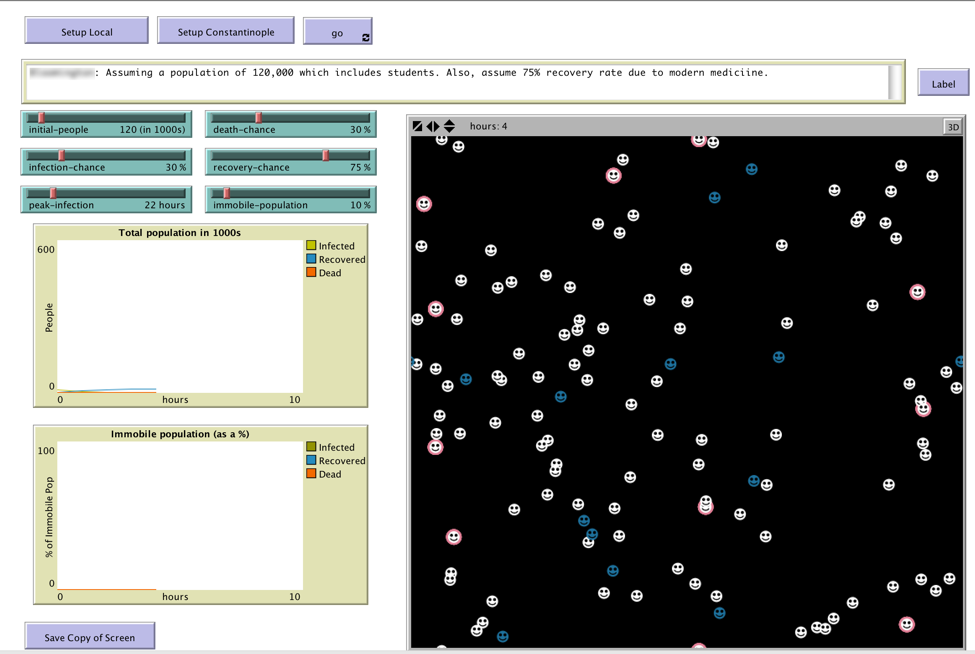Kalani Craig, Charlie Mahoney, Joshua Danish. "Correcting for Presentism in Student Reading of Historical Accounts Through Digital-History Methodologies", in AERA 2017 Annual Meeting Conference Proceedings, San Antonio, TX, April 26-May 1, 2017. DOI: https://convention2.allacademic.com/one/aera/aera17/index.php?cmd=Online+Program+View+Paper&selected_paper_id=1183292&PHPSESSID=pe1f9aoocp20trbmtioab4tft6
In this study, we use activity theory to design an intervention that supports one facet of students’ historical thinking by breaking down modern context and using it to help students reconstruct historical context . Our goal was to expose students’ present context using spatial history, help them tie that present context to the past using an epidemiology simulation, and then use both tools together to connect their contextual understanding back to primary sources about plague spread.
This paper, based on research in Fall of 2015, was peer-reviewed and presented at AERA 2017 in San Antonio. Based on these results, a revised version of the intervention took place in Fall of 2016. Results are still forthcoming, but the revised simulation and activity are available for download
From iPhones to networked refrigerators, the integration of “digital” into our daily lives has become more and more common. These digital tools are becoming a central part of the higher-education classroom. Researchers who have integrated GIS, text mining and network theory into their humanities and history research also tout anecdotal observations about improved engagement, deeper historical thinking skills, and career skills in history classrooms (Dougherty & Nawrotzki, 2013; Kelly, 2013). This paper seeks to add an empirical account of leveraging digital tools and digital history techniques in a history classroom. We build on activity theory (Engeström, 1987; Greeno, 2006; Vygotsky, 1978) to articulate how these tools can help students create better historical context for their primary sources, an important but under-developed skill for many undergraduate history students.
Background and Design Approach
Digital-history pedagogy is often explicitly collaborative (Cohen et al., 2008; Corley, 2013; Daniel, 2012; R. Stephens & Thumma, 2005; R. P. Stephens, Jones, & Barrow, 2011), and activity theory offers a systematic approach to managing its many moving parts (Blin & Munro, 2008) by situating learning in a sociocultural environment. We use activity theory as a heuristic to account for the key mediators of students’ activity: the tools they use, rules they follow, community they interact with, and the division of labor that organizes them.
Activity theory makes environment variables and barriers to historical thinking visible and highlights a gap between expert and novice historians: The former see their primary learning objective as the creation of an argument (Carr, 1961; 1987; Novick, 1988), while the latter are likely to see facts as their primary learning objective (Middendorf, Díaz, Pace, & Shopkow, 2007; Wineburg, 2001). In turn, novice historians see primary sources as their only tool, while experts see primary sources as one tool among many (e.g. historical context, corroborating sources). The relationship between these contextual tools and a larger historical argument exposes the presentist perspective novice historians adopt in their interpretations, which can render modern context invisible and historical context backwards (Reisman, 2015; Takacs, 2003).
Primary sources need to be broken down differently for digital tools than for Socratic-method discussions. For the latter, the underlying mediating tool for discussion is student close-reading applied to an entire primary source (Pace, 2004), while the former requires smaller pieces of data drawn from the primary source. For instance, spatial history as a mediating tool requires a rule that students break geographic information from a long narrative into smaller points on a digital map. Group work fosters additional discussion centered on negotiating precise geography from imperfect primary sources. The patterns students draw from an exploration of the resulting interactive map provides a re-interpretation of the primary source in a way that augments and complements whole-text close-reading, which is still an important part of a history classroom.
Activity Designs
In this study, we use activity theory to design an intervention that supports one facet of students’ historical thinking by breaking down modern context and using it to help students reconstruct historical context (Stanford History Education Group, 2016). Our goal was to expose students’ present context, help them tie that present context to the past, and then connect their contextual understanding back to the primary sources about plague spread.
| Activity structure | Learning objective |
| GPS Modern Route Tracking |
|
| Historical Route Creation |
|
| NetLogo Simulation |
|
The first tool was ViewRanger (http://www.viewranger.com/en-US), a smartphone app that makes students’ contemporary context explicitly salient by tracking one day of each students’ walking and driving paths. We then imported and overlaid all of these paths in Google Maps so students could explore how their movement fostered social interaction and possible plague transmission in their own town using familiar software.

To transfer student understanding of modern context into a historical context, we took advantage of the fact that this particular Midwestern college town is approximately the same square mileage as the sixth-century walls of Constantinople, but with a dramatically different population density (120,000 people vs. an estimated 500,000-800,000 residents, respectively). We made the similarities and differences between their modern context and Constantinople explicit by using that same tool to explore the geography described in primary sources from sixth-century Constantinople.

Finally, we complicated that somewhat simplistic geographic comparison of contexts by using a modified epidemiology simulation built in NetLogo (Yang & Wilensky, 2011). It allowed students to explore changes in population density and movement on the death rates they encountered in their modern context (Figure 3: Results of Midwestern Town NetLogo Simulation) and in primary sources drawn from sixth century and fourteenth century plague accounts (Figure 4: Results of Constantinople NetLogo Simulation). The combination drew student attention to information from primary sources and stabilized the context in which those primary sources were set (Reisman, 2015).


Methods
Participants and data sources
Our research questions address how activity theory can be used to design activities that help students integrate digital history methodology with scientific reasoning and historical thinking in a productive manner.
-
Do students successfully appropriate historical thinking when their traditional history exercises are accompanied by digital history activities?
-
How does engaging in patterns of science reasoning, historical thinking or a combination of the two affect learning outcomes?
This study was implemented with 65 college students in a 200-level history survey about bubonic plague at a public university in a small Midwestern town. Students were divided into 11 groups of 5-7 students at the beginning of the semester by skill and previous history-course experience. Five groups of students volunteered to have their work video-recorded over the course of the two 75-minute sessions. Each of the two participating teachers circulated to answer questions and the lead instructor facilitated large group discussion between shifts in activity structure.
Examining student learning
We collected several sources of data. First, we collected video from 5 student groups during both sessions in the intervention to track and categorize student utterances and group interactions. Based on these videos, we used a thematic analysis (Braun & Clarke, 2006; Wilensky, 1999) to establish three sets of codes focused on historical reasoning, scientific reasoning and inquiry (Table 2: Codes). To better understand how the integration of digital tools, science reasoning and historical thinking fostered student learning gains, we focused primarily on sustained discussion, an uninterrupted period of at least 5 minutes that received the same code for the entire duration. We also looked for sustained discussion that combined codes from several categories (Table 3: Pre/Posttest Survey Questions). Improvement in student understanding of historical context was measured by changes in the pre- to post-test on three variables: correct prediction of the comparative speed of plague spread in their Midwestern town (slow) versus Constantinople (fast); reliance on historical primary sources to make that prediction; and the number of other information sources used with primary sources to make their prediction.
Results
Learning Gains
We saw dramatic improvement in student understanding of how plague spread would differ between two towns that share the same square footage but have significantly different population densities. Twelve students out of sixty five correctly predicted in the pre-test that high population density would be the most important factor in speeding up plague spread (Cohn Jr., 2008), and therefore Constantinople would see much faster spread and higher infection rates than the Midwestern college town (Figure 5: Pretest Plague-Spread Speed Predictions). At the end of session two, 49 students believed plague would spread significantly faster in Constantinople (Figure 6: Posttest Plague-Spread Speed Predictions). Of the remaining 26 students, only seven suggested that plague spread would take less time or the same time in Constantinople. Dependence on primary sources improved from 13 students to 30 students in the pre-post test measures, and students reported using an average of 2.6 sources in the pre-test versus an average of 3.1 sources in the post-test.
Analysis of Learning Gains
While the quantitative improvements are valuable, we were also interested in examining the classroom activities that helped to produce them. During whole-class discussion at the end of day 2, three students from three different groups expressed surprise at how mapping and epidemiology had shifted their response to the primary sources. One student noted: “It opened my eyes to how fast people were really dying.” A second said, “It just visualized it in a clear way, especially when you compare [Midwestern town] to Constantinople and you can really see a concrete effect…instead of just reading the words.” Student 3 had the most complex response: “Just seeing the inevitability of death in Constantinople with that density of people. The visualization of something that didn’t really seem very [serious]…. You think a lot of the population died, yeah, but you wouldn’t think that these [primary source authors] are really, I mean they see a lot of people around them but you think there’s other parts of the population that survive, but there’s a very large death rate.”
In their initial reading, students did not accept primary-source descriptions of dramatic disruption, overwhelming sorrow and dread in cities affected by plague. Student 3 even implied that the authors of the primary sources were exaggerating. These three examples suggest that digital tools provided additional context that close reading did not. Students could root themselves in familiar social interaction and population density in Google Maps, and then use that familiar context in the simulation exercise to both provide a more careful assessment of the context, and to corroborate the descriptions of plague spread contained in primary sources.
While each group saw significant learning gains, some groups saw all students reporting learning gains, while other groups saw only modest gains for a few students. An interactional analysis (CITE) of the five groups that provided video data points to two factors: interactional focal point and mixed-content sustained discussion.
In two 6-student groups, 3 students correctly predicted plague-spread speed and reported increased use of primary sources to build and corroborate historical context in the post-test, while three did not. Video shows these groups seated in two rows of three students each, with multiple laptops limiting interaction between subgroups. In contrast, video of 3 groups in which all students correctly predicted plague-spread speed shows students gathered around one laptop, though seating arrangement varied among the groups.
A second factor was sustained discussion. Groups that demonstrated sustained interactions of five minutes of consecutive talk in a single content domain performed better than groups with minimal interaction. Further, groups with sustained discussion combining simulation-based inquiry and science reasoning first, followed by a similarly sustained historical reasoning discussion, demonstrated marked improvement for all group members, regardless of individual pre-test responses.
Further qualitative analysis of the video suggests that focusing primarily on historical or scientific inquiry was not as productive as synthesizing across the two content domains. Groups with only sustained historical discussion did not adequately account for epidemiological patterns of plague spread in the primary sources. Similarly, groups with only sustained science discussion could not effectively comparing how plague would spread in both modern and historical contexts.
Summary and Significance
Our initial hypotheses that digital tools would provide effective mediation for constructing historical context, and that integrating science reasoning and historical thinking would similarly improve student contextualization, both bear out. Digital tools effectively supported improvement in student understanding of historical context, and these learning gains were more pronounced for groups who showed sustained discussion in both science reasoning and historical thinking.
Attention to several other interactional considerations would further improve learning gains: the organization of space, access to technology and better ties between the simulation and historical vocabulary. First, seating arrangements affect learning gains. Divided seating limited learning gains and interfered with the single-laptop focal point that fostered sustained discussion. Finally, variable labels in the NetLogo simulation could more closely hew to the vocabulary from primary historical sources, which would underscore the connections between NetLogo and primary-source narratives the instructor drew in instruction slides during the simulation activity.
